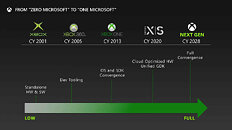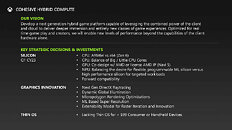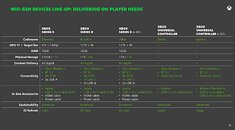- Joined
- Oct 9, 2007
- Messages
- 47,585 (7.45/day)
- Location
- Dublin, Ireland
| System Name | RBMK-1000 |
|---|---|
| Processor | AMD Ryzen 7 5700G |
| Motherboard | ASUS ROG Strix B450-E Gaming |
| Cooling | DeepCool Gammax L240 V2 |
| Memory | 2x 8GB G.Skill Sniper X |
| Video Card(s) | Palit GeForce RTX 2080 SUPER GameRock |
| Storage | Western Digital Black NVMe 512GB |
| Display(s) | BenQ 1440p 60 Hz 27-inch |
| Case | Corsair Carbide 100R |
| Audio Device(s) | ASUS SupremeFX S1220A |
| Power Supply | Cooler Master MWE Gold 650W |
| Mouse | ASUS ROG Strix Impact |
| Keyboard | Gamdias Hermes E2 |
| Software | Windows 11 Pro |
Microsoft Xbox Series X/S, their hardware refreshes, and variants, will reportedly be the company's mainstay all the way up until 2028, the company disclosed in its documents filed as part of its anti-trust lawsuit with the FTC. In a presentation slide titled "From "Zero Microsoft" to "Full Microsoft," the company explains how its next gen Xbox, scheduled for calendar year (CY) 2028, will see a full convergence of Microsoft co-developed hardware, software, and cloud compute services, into a powerful entertainment system. It elaborates on this in another slide, titled "Cohesive Hybrid Compute," where it states the company's vision to be the development of "a next generation hybrid game platform capable of leveraging the combined power of the client and cloud to deliver deeper immersion and entirely new classes of game experiences."
From the looks of it, Microsoft fully understands the creator economy that has been built over the gaming industry, and wants to develop its next-gen console to target exactly this—a single device from which people can play, stream, and create content from—something that's traditionally reserved for gaming desktop PCs. Game streamers playing on consoles usually have an entire creator PC setup handling the production and streaming side of things. Keeping this exact use-case in mind, Microsoft plans to "enable new levels of performance beyond the capabilities of the client hardware alone," by which it means that not only will the console rely on its own hardware—which could be jaw-dropping powerful as you'll see—but also leverage cloud compute services from Microsoft.



Before all else, the hardware. Microsoft dropped its first confirmation that its partnership with AMD for the semi-custom SoC at the heart of its consoles, will continue into the late 2020s. AMD holds both x86 and Arm licenses, and the CPU component of this chip could feature either Arm or x86-64, and if Microsoft picks the latter, it expects to use AMD's "Zen 6" microarchitecture" for its CPU. Given that AMD plans to launch "Zen 5" in 2024, "Zen 6" is highly likely to not only release, but also mature by 2028. Microsoft will definitely look to have a hybrid CPU core admixture (similar to Arm big.LITTLE), where there are two or more kinds of CPU cores in an SoC that operate at entirely different performance/Watt bands from each other.
The GPU will either be co-designed with AMD, or be licensed from it; and will be based on "Navi 5," which is very likely the generation of AMD GPUs based on the RDNA5 graphics architecture, which is at least two generations ahead of the current RDNA3. Microsoft also wants the silicon to feature an NPU for on-device AI acceleration. AMD's XDNA NPU driving the "Hawk Point" mobile processor already claims performance at par with Intel's NPU driving the Core Ultra "Meteor Lake," with the company expected to step up performance in 2024 with XDNA2 that debuts with "Strix Point."
As for the graphics software stack, Microsoft is expected to release the next generation DirectX API sometime between now and 2028. The company's 2024 release of the Windows 12 PC operating system could serve as a good springboard for a new DirectX version. The slide references a "next generation" DXR component. It also talks about dynamic global illumination; a generational uplift in geometric fidelity with micropolygon rendering optimizations; and a proprietary super resolution technology that leverages AI. The company also touches upon its next generation universal controller, codenamed "Igraine," with a "direct to cloud" connectivity.
View at TechPowerUp Main Site | Source
From the looks of it, Microsoft fully understands the creator economy that has been built over the gaming industry, and wants to develop its next-gen console to target exactly this—a single device from which people can play, stream, and create content from—something that's traditionally reserved for gaming desktop PCs. Game streamers playing on consoles usually have an entire creator PC setup handling the production and streaming side of things. Keeping this exact use-case in mind, Microsoft plans to "enable new levels of performance beyond the capabilities of the client hardware alone," by which it means that not only will the console rely on its own hardware—which could be jaw-dropping powerful as you'll see—but also leverage cloud compute services from Microsoft.



Before all else, the hardware. Microsoft dropped its first confirmation that its partnership with AMD for the semi-custom SoC at the heart of its consoles, will continue into the late 2020s. AMD holds both x86 and Arm licenses, and the CPU component of this chip could feature either Arm or x86-64, and if Microsoft picks the latter, it expects to use AMD's "Zen 6" microarchitecture" for its CPU. Given that AMD plans to launch "Zen 5" in 2024, "Zen 6" is highly likely to not only release, but also mature by 2028. Microsoft will definitely look to have a hybrid CPU core admixture (similar to Arm big.LITTLE), where there are two or more kinds of CPU cores in an SoC that operate at entirely different performance/Watt bands from each other.
The GPU will either be co-designed with AMD, or be licensed from it; and will be based on "Navi 5," which is very likely the generation of AMD GPUs based on the RDNA5 graphics architecture, which is at least two generations ahead of the current RDNA3. Microsoft also wants the silicon to feature an NPU for on-device AI acceleration. AMD's XDNA NPU driving the "Hawk Point" mobile processor already claims performance at par with Intel's NPU driving the Core Ultra "Meteor Lake," with the company expected to step up performance in 2024 with XDNA2 that debuts with "Strix Point."
As for the graphics software stack, Microsoft is expected to release the next generation DirectX API sometime between now and 2028. The company's 2024 release of the Windows 12 PC operating system could serve as a good springboard for a new DirectX version. The slide references a "next generation" DXR component. It also talks about dynamic global illumination; a generational uplift in geometric fidelity with micropolygon rendering optimizations; and a proprietary super resolution technology that leverages AI. The company also touches upon its next generation universal controller, codenamed "Igraine," with a "direct to cloud" connectivity.
View at TechPowerUp Main Site | Source







